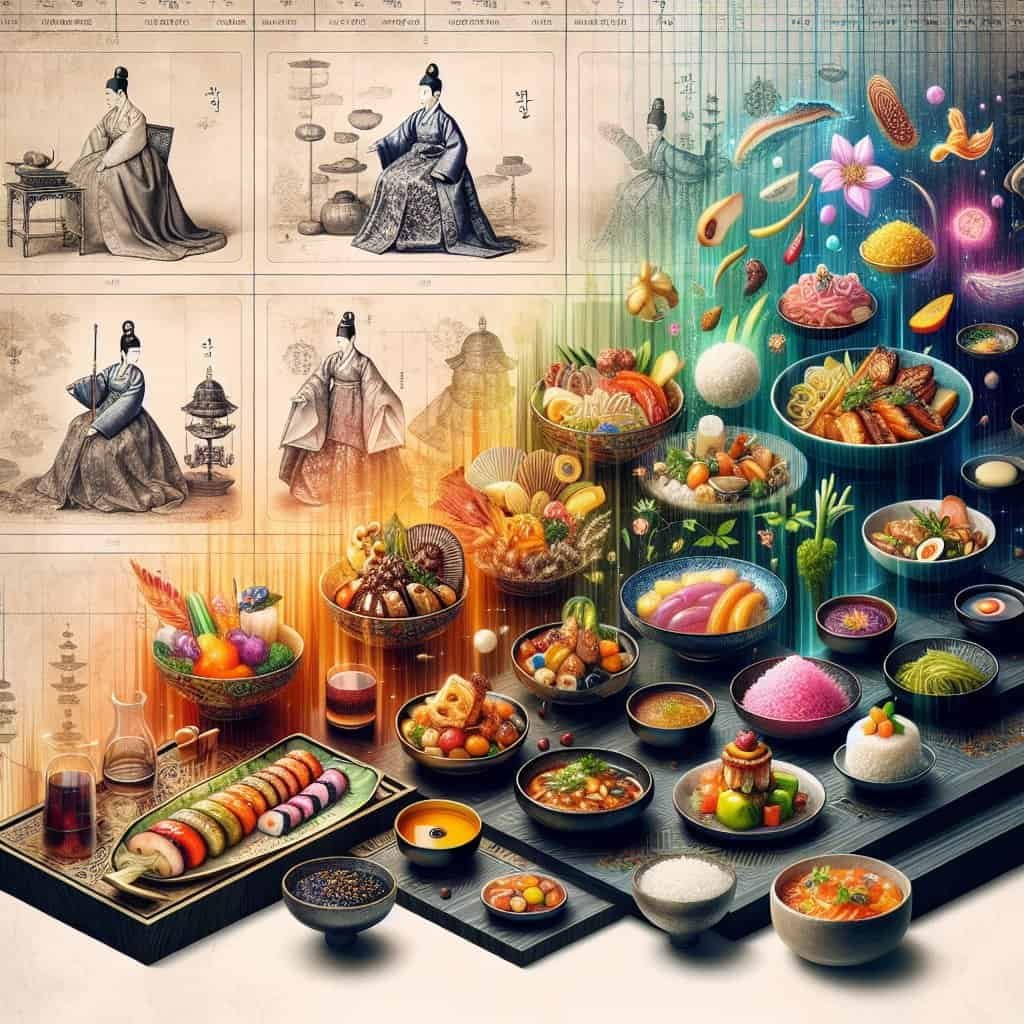Imagine dining like royalty, indulging in exquisite dishes that have been passed down through generations. Korean royal cuisine, known as gujeolpan, has made a significant impact on modern Korean dishes. With its emphasis on fresh ingredients, delicate presentation, and harmonious flavors, royal cuisine has influenced the way food is prepared and enjoyed in Korea today. From the vibrant colors to the intricate plating techniques, the influence of gujeolpan can be seen in the visually stunning dishes that grace the tables of modern Korean restaurants. Discover how these ancient culinary traditions continue to shape the vibrant and flavorful world of Korean cuisine.

Introduction
Korean cuisine is renowned for its rich flavors, diverse ingredients, and vibrant colors. At the heart of this culinary tradition lies Korean Royal Cuisine, a sophisticated and elegant style of cooking that has had a significant impact on modern Korean dishes. In this article, we will explore the origins, characteristics, and techniques of Korean Royal Cuisine, as well as its influence on contemporary culinary practices.
Overview of Korean Royal Cuisine
Definition and significance
Korean Royal Cuisine, also known as Joseon Royal Cuisine, refers to the traditional cooking style that was enjoyed by the Korean royal court during the Joseon Dynasty (1392-1897). It was a refined and elaborate form of gastronomy that emphasized harmony, balance, and the use of fresh and high-quality ingredients. The significance of Korean Royal Cuisine lies in its cultural and historical value, as well as its contribution to the development of Korean culinary traditions.
Characteristics of Korean Royal Cuisine
Korean Royal Cuisine is characterized by its simplicity, elegance, and emphasis on natural flavors. It avoids excessive seasoning and relies on the natural tastes of ingredients. It also places great importance on presentation, with dishes being meticulously arranged on the plate to enhance visual appeal. The use of seasonal produce and an array of cooking methods adds depth and variety to the cuisine, resulting in a harmonious and balanced dining experience.
Historical Background
Origin of Korean Royal Cuisine
The origins of Korean Royal Cuisine can be traced back to the early days of the Joseon Dynasty. During this time, the royal court sought to establish a distinct culinary culture that reflected the grandeur and sophistication of the royal household. Royal chefs were highly skilled and dedicated to perfecting their craft, resulting in the development of a unique and refined cooking style.
Role of Korean royal court
The Korean royal court played a pivotal role in the development and preservation of Korean Royal Cuisine. It was responsible for cultivating the finest ingredients, employing skilled chefs, and setting culinary standards. The recipes and cooking techniques were closely guarded secrets, passed down through generations within the royal family. The royal court also played a significant role in promoting the use of seasonal produce and sustainable farming practices.
Evolution of Korean Royal Cuisine
Over the centuries, Korean Royal Cuisine has evolved and adapted to changing tastes and influences. It has assimilated elements from Chinese and Japanese cuisines, as well as embracing new cooking techniques and ingredients introduced through trade and cultural exchanges. Despite these changes, the essence of Korean Royal Cuisine, with its emphasis on simplicity and harmony, has remained intact.
Ingredients and Cooking Methods
Distinctive ingredients in Korean Royal Cuisine
Korean Royal Cuisine features a wide range of distinctive ingredients that are carefully selected and prepared to achieve optimal taste and texture. Some of the key ingredients include chestnuts, jujubes, bamboo shoots, edible flowers, pine nuts, and various types of mushrooms. These ingredients not only enhance the visual appeal of the dishes but also contribute unique flavors and aromas.
Use of seasonal produce
Seasonality is a fundamental principle in Korean Royal Cuisine. The use of fresh, seasonal ingredients ensures the highest quality and enhances the natural flavors of the dishes. The royal court was known for its extensive gardens where a variety of fruits, vegetables, and herbs were grown, ensuring a constant supply of the freshest produce throughout the year.
Cooking methods and techniques
Korean Royal Cuisine encompasses a wide range of cooking methods and techniques. Steaming, boiling, stir-frying, braising, and grilling are some of the common techniques employed. There is also a strong emphasis on fermenting foods, as evidenced by the use of jeotgal, a type of fermented seafood that adds depth and complexity to dishes. The combination of various cooking methods and techniques creates a diverse array of flavors and textures.

Influence on Modern Korean Dishes
The influence of Korean Royal Cuisine on modern Korean dishes is profound and far-reaching. Many of the cooking techniques, ingredient pairings, and flavors used in contemporary Korean cuisine can be traced back to this royal gastronomic tradition. The use of seasonal produce, emphasis on balance, and meticulous presentation are all elements that have been integrated into modern Korean cooking.
Royal Cuisine Techniques Adapted
Incorporation of jeotgal (fermented seafood)
One of the notable techniques adopted from Korean Royal Cuisine is the use of jeotgal, a fermented seafood condiment. In traditional royal dishes, jeotgal played a crucial role in enhancing flavors and adding complexity. This technique has been widely incorporated into modern Korean cuisine, with jeotgal often used as a seasoning or accompaniment to dishes, lending a unique umami flavor.
Fusion of flavors and textures
Korean Royal Cuisine’s emphasis on balance and harmony has influenced the fusion of flavors and textures in modern Korean dishes. Traditional royal dishes often combined ingredients with contrasting tastes and textures to create a harmonious balance on the plate. This practice has been embraced by contemporary chefs, leading to the creation of innovative dishes that juxtapose sweet, salty, sour, and spicy flavors with crunchy, creamy, and chewy textures.

Preservation of Traditional Royal Recipes
Role of royal cuisine in preservation
Korean Royal Cuisine has played a crucial role in the preservation of traditional culinary techniques and recipes. It has served as a repository of knowledge and a source of inspiration for modern chefs and food enthusiasts. The dedication to preserving the authenticity and integrity of royal recipes ensures that future generations can continue to experience and appreciate the rich cultural heritage of Korean cuisine.
Modern interpretation of royal dishes
While traditional royal recipes are cherished and preserved, there has also been room for modern interpretation and innovation. Chefs have taken inspiration from Korean Royal Cuisine and transformed classic dishes using contemporary cooking techniques and ingredients. This approach allows for a reimagining of royal dishes, ensuring their relevance in a rapidly evolving culinary landscape.
Popularization of Royal Dishes
Restaurants specializing in royal cuisine
In recent years, there has been a growing popularity and appreciation for Korean Royal Cuisine, leading to the establishment of restaurants specializing in these traditional dishes. These restaurants not only offer a glimpse into the royal culinary heritage but also provide an opportunity for diners to savor the unique flavors and experience the refined dining atmosphere associated with Korean Royal Cuisine.
Integration of royal dishes in contemporary menus
Korean Royal Cuisine has also found its place in modern dining establishments, with many contemporary Korean restaurants incorporating royal dishes into their menus. These restaurants are known for their innovative approach to blending traditional and modern flavors, offering a fresh take on Korea’s gastronomic traditions. This integration ensures that the legacy of Korean Royal Cuisine continues to thrive and evolve.

Modern Interpretation and Innovation
Creative fusion dishes
In addition to preserving traditional dishes, modern chefs have been experimenting with creative fusion dishes that blend Korean Royal Cuisine with international culinary influences. This approach not only showcases the versatility and adaptability of Korean culinary traditions but also offers diners a unique and exciting dining experience that combines familiar flavors with innovative twists.
Incorporation of international culinary influences
Korean Royal Cuisine has also been influenced by international culinary trends and ingredients. Globalization has opened up new avenues for experimentation, resulting in the incorporation of foreign techniques and flavors into Korean Royal Cuisine. This fusion of international influences with traditional Korean cooking techniques and ingredients has created a vibrant culinary landscape that reflects the multicultural nature of modern Korean society.
Conclusion
Korean Royal Cuisine is not just a culinary style; it is a testament to the rich cultural heritage of Korea. Its influence on modern Korean dishes is evident in the use of seasonal produce, balance of flavors, and meticulous presentation. By preserving traditional recipes, adapting techniques, and embracing innovation, Korean Royal Cuisine continues to inspire chefs and delight diners, ensuring its legacy lives on in the vibrant and evolving landscape of Korean cuisine. So whether you’re dining in a traditional royal restaurant or sampling a modern interpretation, be prepared to savor the essence of centuries-old culinary traditions combined with the excitement of contemporary flavors.

